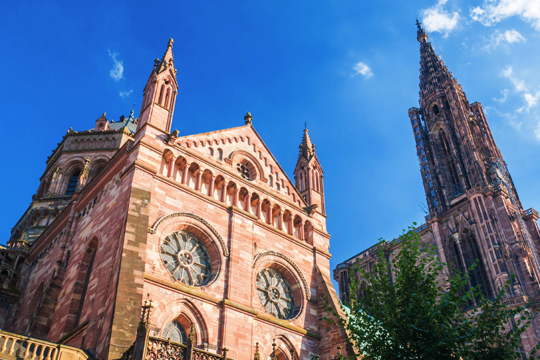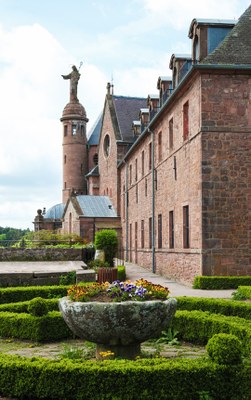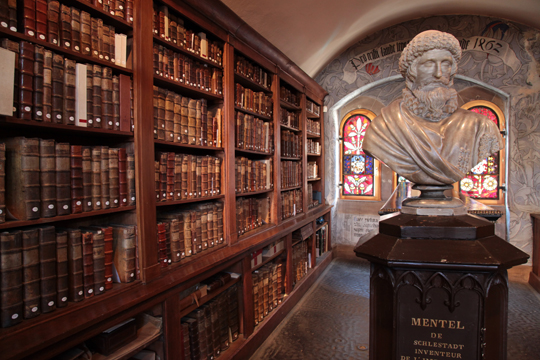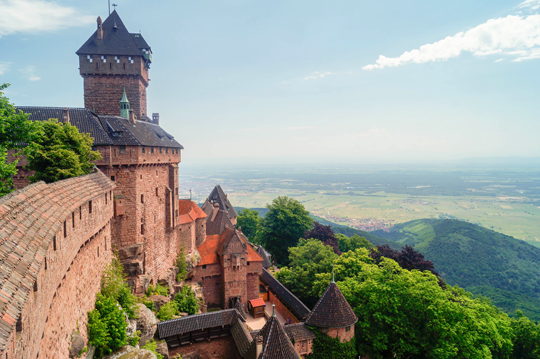A journey through the region
Freiburg, Sep 04, 2017
Fotos: Alexi Tauzin/Fotolia, jorisvo/Fotolia, Alexandre Dulaunoy/Wikimedia Commons, jojojo07/Fotolia, Joergens.mi/Wikimedia Commons
Cologne Cathedral, Notre Dame, Sistine Chapel: The Middle Ages brought forth many significant structures – also in our area. In a new release entitled Erinnerungsorte des Mittelalters am Oberrhein (Memorial Sites in the Middle Ages on the Upper Rhine), researchers show that the ornate cathedrals of Freiburg and Strasbourg are not the only impressive sights worth seeing from the Middle Ages in the border triangle. Several historically valuable architectonic gems are not far from our very doorstep – from picturesque castle ruins to unusual libraries and modern monuments in Freiburg’s city center.

Strasbourg Cathedral
The journey begins in Strasbourg, France: The cathedral located there is a Roman Catholic church and is one of the most significant cathedrals in European architectural history. With a height of 142 meters, the tower was the highest one built on the European mainland during the Middle Ages. The Strasbourg Cathedral has a long construction history. Beginning in the 12th century, it wasn’t complete until the end of the 16th century. Due to the long construction period and ever-changing architects, the blueprint was changed multiple times and implemented differently, depending on who was in charge. As a result, individual structural elements emerged that were, in and of themselves, perfect, but in its entirety does not create a harmonious picture. Nevertheless, or perhaps because of it, the Strasbourg Cathedral, with its characteristically asymmetric form, has remained emblematic of Strasbourg and of the entire Alsatian region.

Perfect individual structures that are disharmonious in their entirety: Over the course of its 400 year construction history, the Strasbourg Cathedral went through a lot of architects. Photo: Alexi Tauzin/Fotolia
Hohenburg Abbey and Saint Odilia
After Strasbourg, the journey continues around 40 kilometers southwest to Hohenburg Abby and the Saint Odilia. According to legend, the patron saint of Alsace and eyesight was born blind in the 7th century A.D. and was banished by her father. The mother secretly gave her away to an abbey to be raised there. At the age of 12, Odilia was baptized and, by some miracle, could suddenly see. Because she no longer harmed her own family’s reputation, she asked her brother if she could come home again. When her father learned of Odilia’s return, he angrily killed his own son with a rod. He regretted the act so much that he turned his castle into an abbey and named Odilia its first abbess. The abbey, which is fully open to the public, is known today as the saint’s largest memorial site. An interior building houses the sarcophagus with some of Odilia’s relics.

As patron saint of Alsace and eyesight, Saint Odilia reigns nobly over the Hohenburg Abbey. According to legend, she was its first abbess. Photo: jorisvo/Fotolia
Classics Library in Schlettstadt
25 kilometers south in a small town called Schlettstadt with yet another Alsatian emblem: The Classics Library is considered one of the most significant cultural treasures in the region and consists of two individual book collections. There is a library from the old Latin school in Schlettstadt. It was renovated during the 15th and 16th centuries through foundations and an endowment from former teachers and alumni, thereby receiving its humanistic image. There is also a building that stores the private library of the scholar Beautus Rhenanus that he granted his hometown. The Rhenanus book collection is the only larger classics library that has been nearly completely preserved. For this reason, UNESCO listed the library in its Memory of the World Register in 2011. Since 1889, both libraries’ valuable stacks have been unified under one roof: in the former market hall near the Gothic church St. George, serving not only as library but also museum.

The magnificent library from the scholar Beatus Rhenanus has been listed in UNESCO’s Memory of the World Register since 2011. Photo: Alexandre Dulaunoy/Wikimedia Commons
Haut- Koenigsbourg Castle near Schlettstadt
Just a few kilometers from Schlettstadt is the largest castle ruins in Alsace. Upon its completion in the 12th century, the Haut-Koenigsbourg Castle witnessed multiple inner-European conflicts and rivalries between owners, emperors and kings. After Swedish troops destroyed the castle in 1633 during the Thirty Year War, it lost all meaning for some time. It wasn’t until the 20th century that Emperor William II decided to reconstruct it after the city council in Sclettstadt had given him the Haut-Koenigsbourg as a gift. The residents in Alsace had hoped that the reconstruction would elevate the area’s status to a State with its own constitution and parliament, but that was not the case under the Emperor’s reign. Today Haut-Koenigsbourg receives more than half a million annual visitors and is one of the most popular historical sights in France and, along with the Strasbourg Cathedral, the most well-known structure in Alsace.

After its completion in the 12th century, the Haut-Koenigsbourg has been a quiet witness to many inner-European conflicts. Today the castle ruins lure more than one-half million annual visitors to its grounds. Photo: jojojo07/Fotolia
The House of Zähringen
After Schlettstadt, we return to Germany on the trail of one of the largest medieval families in the former duchy of Swabia. The House of Zähringen or, put another way: The family of the Bertholds who are considered the founders of the city of Freiburg as well as the erectors of the Freiburg Cathedral. Duke Bertold V., the last true member of the House of Zähringen, passed away at the beginning of the 13th century. To this day, many structures and symbols coming from or commemorating that time adorn Freiburg. In particular, the Castle of Zähringen in the urban quarter with the same name along with the equestrian statue at the Bertold fountain refer to the city’s founders. The contemporary monument in the city center had a predecessor from the early 19th century that was erected for Freiburg’s transition to Baden. After the British destroyed the so-called fish fountain during an airstrike in November 1944, the sculptor Nikolaus Röslmeir rebuilt it between 1956 and 1965 using a new blueprint. Visitors can read the inscription: „Den Herzogen von Zähringen, Gründern und Herren von Freiburg im Breisgau“ (“Dedicated to the dukes of Zähringen, the founders and lords of Freiburg im Breisgau”).

The Zähringen monument at Bertold’s fountain, an equestrian statue made of bronze, commemorates the erstwhile founding fathers and lords of the City of Freiburg. Photo: Joergens.mi/Wikimedia Commons
Jannis Behnke
Memorial Sites during the Middle Ages in the Upper Rhine
The new release Erinnerungsorte des Mittelalters am Oberrhein (Memorial Sites in the Middle Ages on the Upper Rhine), stems from a lecture with the same title featured by the Studium generale that introduces several of the border triangle’s most significant structures and history in order to celebrate the 75th anniversary of the Department of National History at the University of Freiburg. As editor, Jürgen Dendorfer, Professor for Medieval History collected the speakers’ lectures into one volume.
Blog Mittelalter am Oberrhein (Middle Ages on the Upper Rhine)

